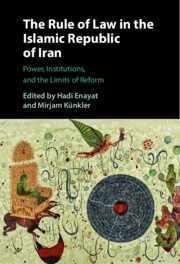Book contents
- The Rule of Law in the Islamic Republic of Iran
- The Rule of Law in the Islamic Republic of Iran
- Copyright page
- Contents
- Figures, Maps and Tables
- Contributors
- Acknowledgments
- Note on Transliteration
- Chronology
- Abbreviations and Glossary
- 1 Governing the Law in the Islamic Republic of Iran
- 2 The Islamic Penal Code of 2013
- 3 The Administration of Criminal Justice in Iran
- 4 Shiʿi Family Law under the Rule of Law? The Iranian Model and Current Approaches in the Shiʿi World
- 5 Rule of Law or Rule by Law? Iran’s Bar Association as a Pawn in Islamic–Republican Contestations
- 6 Law Enforcement and the Judiciary in Postrevolutionary Iran
- 7 The Problem of Overcrowded Prisons in the Islamic Republic of Iran
- 8 Legal Barriers to Accessing Vital Medical Services and Creative Responses to Overcoming These
- 9 Reform from Within? Hākemiyat-e Qānun from the Reformist Era to 2022
- 10 Iran’s Religious and Ethnic Minorities in the Eyes of the Judiciary and the Security Apparatus
- 11 Labor Rights in Postrevolutionary Iran
- 12 The Effects of the Joint Comprehensive Plan of Action (JCPOA), and Subsequent US Withdrawal, on Iranian Law
- 13 Multilayered Mechanisms of Control and Censorship of Arts and Culture in the Islamic Republic of Iran
- 14 The Legal Situation Regarding Assisted Reproduction in Iran
- 15 Conclusions
- Index
- References
11 - Labor Rights in Postrevolutionary Iran
Published online by Cambridge University Press: 10 April 2025
- The Rule of Law in the Islamic Republic of Iran
- The Rule of Law in the Islamic Republic of Iran
- Copyright page
- Contents
- Figures, Maps and Tables
- Contributors
- Acknowledgments
- Note on Transliteration
- Chronology
- Abbreviations and Glossary
- 1 Governing the Law in the Islamic Republic of Iran
- 2 The Islamic Penal Code of 2013
- 3 The Administration of Criminal Justice in Iran
- 4 Shiʿi Family Law under the Rule of Law? The Iranian Model and Current Approaches in the Shiʿi World
- 5 Rule of Law or Rule by Law? Iran’s Bar Association as a Pawn in Islamic–Republican Contestations
- 6 Law Enforcement and the Judiciary in Postrevolutionary Iran
- 7 The Problem of Overcrowded Prisons in the Islamic Republic of Iran
- 8 Legal Barriers to Accessing Vital Medical Services and Creative Responses to Overcoming These
- 9 Reform from Within? Hākemiyat-e Qānun from the Reformist Era to 2022
- 10 Iran’s Religious and Ethnic Minorities in the Eyes of the Judiciary and the Security Apparatus
- 11 Labor Rights in Postrevolutionary Iran
- 12 The Effects of the Joint Comprehensive Plan of Action (JCPOA), and Subsequent US Withdrawal, on Iranian Law
- 13 Multilayered Mechanisms of Control and Censorship of Arts and Culture in the Islamic Republic of Iran
- 14 The Legal Situation Regarding Assisted Reproduction in Iran
- 15 Conclusions
- Index
- References
Summary
Workers’ rights and conditions have not been at the core of the Islamic Republic’s main policies, especially from the 1990s onward. The existent labor law offers far-reaching exemptions and loopholes that make it possible to circumvent workers’ rights, while prohibitions on independent unions deprive workers of the legal tools to claim their rights. This chapter gives a detailed analysis of the evolution of labor regulation and reform in postrevolutionary Iran, building on primary research and interviews with industrial workers, scholars, and legal experts, conducted in Iran. In particular, the chapter demonstrates how, from Rafsanjani’s neoliberal turn to Rouhani’s presidency, labor casualization and job insecurity have gradually – and systematically – undermined working conditions, exposing workers to severe exploitation and limiting their legal protection. The presidents’ policies have not been equally detrimental, as the values behind every administration, as well as the general economic contexts, influenced their choices: from Rafsanjani’s market-oriented rhetoric to Khatami’s participatory narrative of civil society, Ahmadinejad’s conservative populism to Rouhani’s business-friendly pragmatism.
Keywords
- Type
- Chapter
- Information
- The Rule of Law in the Islamic Republic of IranPower, Institutions, and the Limits of Reform, pp. 331 - 356Publisher: Cambridge University PressPrint publication year: 2025

